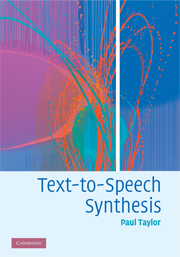Book contents
- Frontmatter
- Contents
- Foreword
- Preface
- 1 Introduction
- 2 Communication and language
- 3 The text-to-speech problem
- 4 Text segmentation and organisation
- 5 Text decoding: finding the words from the text
- 6 Prosody prediction from text
- 7 Phonetics and phonology
- 8 Pronunciation
- 9 Synthesis of prosody
- 10 Signals and filters
- 11 Acoustic models of speech production
- 12 Analysis of speech signals
- 13 Synthesis techniques based on vocal-tract models
- 14 Synthesis by concatenation and signal-processing modification
- 15 Hidden-Markov-model synthesis
- 16 Unit-selection synthesis
- 17 Further issues
- 18 Conclusion
- Appendix A Probability
- Appendix B Phone definitions
- References
- Index
9 - Synthesis of prosody
Published online by Cambridge University Press: 25 January 2011
- Frontmatter
- Contents
- Foreword
- Preface
- 1 Introduction
- 2 Communication and language
- 3 The text-to-speech problem
- 4 Text segmentation and organisation
- 5 Text decoding: finding the words from the text
- 6 Prosody prediction from text
- 7 Phonetics and phonology
- 8 Pronunciation
- 9 Synthesis of prosody
- 10 Signals and filters
- 11 Acoustic models of speech production
- 12 Analysis of speech signals
- 13 Synthesis techniques based on vocal-tract models
- 14 Synthesis by concatenation and signal-processing modification
- 15 Hidden-Markov-model synthesis
- 16 Unit-selection synthesis
- 17 Further issues
- 18 Conclusion
- Appendix A Probability
- Appendix B Phone definitions
- References
- Index
Summary
This chapter is concerned with the issue of synthesising acoustic representations of prosody. The input to the algorithms described here varies but in general takes the form of the phrasing, stress, prominence and discourse patterns which we introduced in Chapter 6. Hence the complete process of synthesis of prosody can be seen as one whereby we first extract a prosodic form representation from the text, as described in Chapter 6, and then synthesize an acoustic representation of this form, as described here.
The majority of this chapter focuses on the synthesis of intonation. The main acoustic representation of intonation is the fundamental frequency (F0), such that intonation is often defined as the manipulation of F0 for communicative or linguistic purposes. As we shall see, techniques for synthesizing F0 contours are inherently linked to the model of intonation used, so the whole topic of intonation, including theories, models and F0 synthesis, is dealt with here. In addition, we cover the topic of predicting intonation form from text, which was deferred from Chapter 6 since we first require an understanding of theories and models of intonational phenomena before explaining this.
Timing is considered the second important acoustic representation of prosody. Timing is used to indicate stress (phones are longer than normal), phrasing (phones become noticeably longer immediately prior to a phrase break) and rhythm.
Intonation overview
As a working definition, we will take intonation synthesis to be the generation of an F0 contour from higher-level linguistic information.
- Type
- Chapter
- Information
- Text-to-Speech Synthesis , pp. 225 - 261Publisher: Cambridge University PressPrint publication year: 2009



